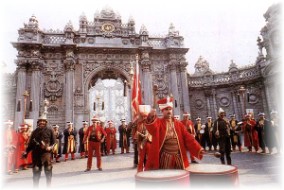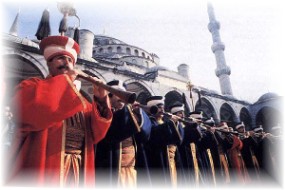 |
||
| Get Original Mehter CD ! |
|
|
|
|
|
|
Ottoman Army Band Mehter |
|
 |
 |
 |
 |
 |
 |
|
Ottoman mehter music, which for centuries accompanied the marching Ottoman army into battle, still echoes in that of drum and zurna - an oboe-like woodwind instrument with seven holes above and one below - which are a part of folk culture all over Turkey. Mehter music was a symbol of sovereignty and independence, and its ardent sounds instilled the soldiers with strength and courage. The rousing songs and crashing sound of the great kös drums were at the same time capable of unnerving the enemy on the brink of battle, and the mehter music composers took pains to create works that produced this effect.The mehter band was established in 1299 when Osman Gazi was made bey or liege lord by the Seljuk sultan Keykubat III, who sent him a tabl (kettledrum) and finial as symbols of rank. However, with the dissolution of the Janissary Corps by Sultan Mahmud II in 1826, the mehter bands were also dispersed, and not until Ferik Ahmed Muhtar Pasa founded the Imperial Military Museum in 1908 was it decided to revive the tradition. In 1914 it was reestablished as the Mehterhane-i Hakani - Royal Mehter Band - attached to the museum. The band was again abolished in 1935 by then minister of defense Zekai Apaydin Bey, only to be reformed in 1952 as an institution of historical interest attached to Istanbul Military Museum. Today the band performs several times a week at the museum, and at certain official ceremonies and is a reminder of former Ottoman glory. The band has its own distinctive marching step, whose rhythm is that of the words, Gracious God is good. God is compassionate. The mehter band marches behind the commander of the band or çorbacibasi, who wears a headdress known as üsküf. After him to his left and right respectively march the bearers of the white and red standards, the latter with an armed guard. Behind these march nine plume bearers three by three, the plume of attack positioned behind the red standard. Then comes the band master in the center, and behind him the çevgâns (jingling instruments in the form of a crescent), zurnas, trumpets, nakkares (small kettledrums beaten with the hands or two sticks), cymbals, davuls (bass drums) and finally the kös drums (giant kettledrums) played on horseback. The mehter band members form a crescent to perform, and play standing except for the nakkare players, who sit cross-legged at the right-hand tip of the crescent, followed anticlockwise by the zurnas, bass drums, cymbals and trumpets. When they march, the band members pause every three steps and turn to right and left in salutation, in a rhythm set by the drums, chanting Rahim Allah, Kerim Allah (Merciful God, Gracious God). In former centuries the mehter band used to play even at night on the battlefield to prevent the camp guards from falling asleep. As well as the instruments already mentioned, a full mehter band could also include two types of zurna (cura and kaba), kurrenay (a kind of horn with a curved end), mehter whistle, clarinet-type wind instruments, tabl, tambourine and other percussion instruments. The mehter bands were primarily military bands, and those under the command of generals included war drums over one meter in height known as harbî kûs or kös. These were carried on camels, and playing them with sticks demanded great skill. The 17th century writer Evliya Çelebi wrote, Each kûs is the size of a bathhouse dome. They are played on feast day nights and days and their sound is like thunder. During performances the kös drums were placed in a line on the ground in the center of the circle of musicians, and when marching they were loaded in pairs onto camels. The drummer rode and struck the drums to his right and left by turn. The kös was only ever played by royal mehter bands, or in that of the commander-in-chief leading the army in lieu of the sultan when on campaign. Each set of players had a leader known as aga. The leader of the bass drum players was called the basmehter aga, and the master of the entire band was called the mehterbasi aga. All the agas and the çevgân players wore white turbans wound around a kavuk (cap), a red coat over a yellow robe and red trousers, a shawl wound around the waist and yellow leather shoes. The other musicians were similarly dressed, except that their kavuks and coats were dark blue. As the Ottomans advanced westwards into Europe, many elements of mehter music influenced western composers, particularly in the 17th century. Later Mozart and Haydn composed music inspired by mehter music, and Beethovens Ninth Symphonys use of the kös, bass drum and zurna in the last movement is another striking example. Mozart, Bizet and many other composers produced alla Turca pieces. The military mehter bands symbolized the sovereignty of the Ottoman state, and their powerful stirring music had a spirit which we can still appreciate today when listening to the museusin mehter band playing this sound out of the past. |
|

